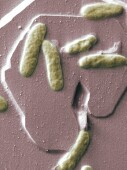But some types of foodborne bacteria, including Campylobacter and Vibrio, are on the rise
THURSDAY, May 14, 2015 (HealthDay News) — The incidence of reported infections with Escherichia coli (E. coli) O157 and a common strain of Salmonella bacteria have decreased, while infections with other types of Salmonella, Campylobacter, and Vibrio have increased, according to research published in the May 15 issue of the U.S. Centers for Disease Control and Prevention’s Morbidity and Mortality Weekly Report.
The new report summarizes data from 2014. Salmonella caused the most infections (38 percent), followed by Campylobacter (33 percent) and E. coli (6 percent). Infections attributed to Shiga toxin-producing E. coli O157 fell 32 percent since 2006 to 2008, according to the report. In addition, infections from Salmonella Typhimurium dropped 27 percent during the same period, continuing a trend that started in the mid-1980s.
Infections from two less common types of Salmonella — Javiana and Infantis — more than doubled. When all types of Salmonella are combined, no change was seen in 2014, according to the researchers. Campylobacter increased 13 percent and Vibrio increased 52 percent, compared with 2006 to 2008.
During a press conference today, Patricia Griffin, M.D., M.P.H., of the Division of Foodborne, Waterborne, and Environmental Diseases at the CDC, said that despite a recent outbreak of listeria from contaminated ice cream, the number of listeria infections hasn’t changed. In 2014, listeria was responsible for 11 percent of foodborne illness outbreaks, according to the report. “We haven’t seen a change in listeria infections since 2006 to 2008,” Griffin said. “Over the long term, when FoodNet started 20 years ago, there’s been a remarkable decrease in listeria infections.”
Full Text
Copyright © 2015 HealthDay. All rights reserved.








